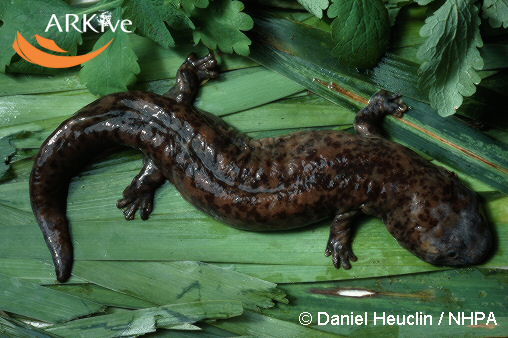Chinese Giant Salamander (Andrias davidianus) {!--중국큰불도롱뇽(와와위)--> Chinese giant salamander (Andrias davidianus)
Also known as: Chinese salamander
Chinese giant salamander on leaves
Status: According to the IUCN Red List criteria, there is not enough information about this species to make an assessment of its risk of extinction based on its distribution and/or population status (DD) It is listed on Appendix I of CITES.
Description
The Chinese giant salamander is the largest salamander in the world, and is fully aquatic, with many adaptations for this lifestyle. It grows up to 1.8 meters in length, though most individuals found today are considerably smaller. The skin is dark brown, black or greenish in colour and irregularly blotched. It is also rough, wrinkled and porous which facilitates respiration through the skin as this large amphibian lacks gills. This species has an elongated body, and two pairs of legs which are roughly similar in size. The snout is less rounded than that of the related Japanese giant salamander and the tail is a little longer and broader. Both species have tubercles on the head and throat, though their arrangement is different. The Chinese species has small, paired tubercles arranged in rows parallel with the lower jaw, while the Japanese species’ tubercles are mostly single and irregularly scattered. The eyes are tiny, with no eyelids, and positioned on top of the broad, flat head, providing the salamander with poor vision.
Credit: ?? Daniel Heuclin / NHPA
Contact details:
NHPA Limited
57 High Street,
Ardingly,
Sussex,
RH17 6TB,
United Kingdom
Tel:+44 (0) 1444 892 514
Fax:+44 (0) 1444 892 168
Email:nhpa@nhpa.co.uk
Website:http://www.nhpa.co.uk
